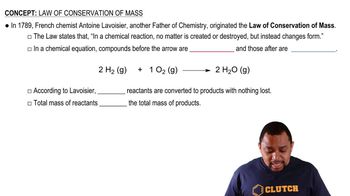Here are the essential concepts you must grasp in order to answer the question correctly.
Nuclear Reactions
Nuclear reactions involve changes in an atom's nucleus and can result in the transformation of one element into another. These reactions include processes such as alpha decay, beta decay, and nuclear fission. Understanding the type of nuclear reaction is crucial for balancing nuclear equations, as it dictates the particles involved and the resulting products.
Recommended video:
Conservation of Mass and Charge
In nuclear equations, both mass and charge must be conserved. This means that the total mass number (sum of protons and neutrons) and the total charge (sum of positive and negative charges) on both sides of the equation must be equal. This principle is essential for correctly balancing nuclear equations, ensuring that the number of nucleons and the charge are accounted for.
Recommended video:
Law of Conservation of Mass
Notation of Nuclear Particles
Nuclear particles are represented using specific notation, where elements are denoted by their chemical symbols, and their mass and atomic numbers are indicated as superscripts and subscripts, respectively. For example, an alpha particle is represented as 4He2. Familiarity with this notation is necessary for accurately writing and balancing nuclear equations, as it helps identify the particles involved in the reaction.
Recommended video:
Standard Notation to Scientific Notation
 Verified step by step guidance
Verified step by step guidance


